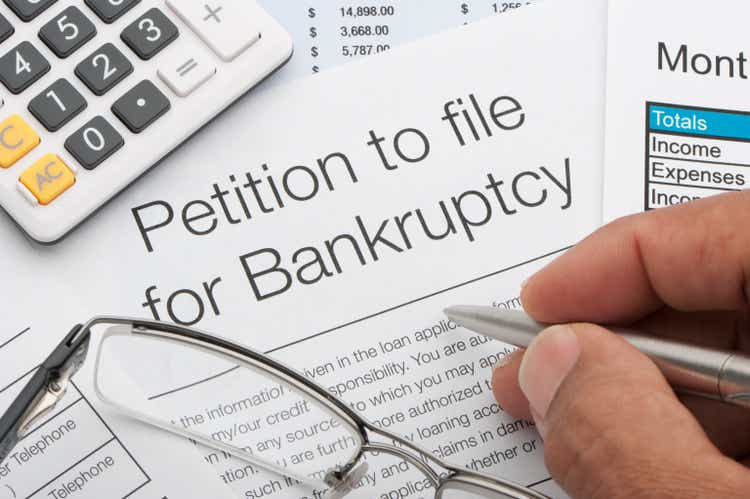courtneyk
The Bankruptcy Filing
Endo International (NASDAQ:ENDP) filed a petition for bankruptcy on August 16th after reaching an RSA (restructuring support agreement) with a majority of its first lien debt holders. The company hired Skadden, Arps, PJT Partners and Alvarez & Marsal as bankruptcy advisors. As per usual in bankruptcy cases, the various advisors and lawyers will feast on the carcass and will be paid first.
The first lien debt holders are essentially offering to buy the company for $6 billion and offering a $550 million settlement for opioid litigants. 35 state AGs have agreed to settle with the company. The secured holder offer is what is known as a stalking horse bid. The details are a bit scant, but judging by first lien debt in the high 80s to low 90s, second lien in mid-20s and unsecured in mid-single digits, I expect the first liens to get some sort of small reinstatement of debt and most of the equity here while the second liens and unsecureds get some small amount of equity. Equity holders will be wiped out. The shares currently have a small bid. Perhaps there are day trades to be had there, but ultimately I expect zero value unless the company’s performance recovers amazingly during the year, which I consider unlikely This case will now come down to valuation and a judge will have to confirm that valuation and all settlements.
Last summer, I originally believed that bankruptcy protection would be the company’s way of settling its opioid claims, with the potential loss of the Vasostrict patent trial as an added operational risk. However, even I, as bearish as I was on the company, did not expect Vasostrict profits to vaporize so quickly and for the company’s operations to deteriorate at such velocity. Sometimes, you aren’t bearish enough.
What Investors Can Learn from This Bankruptcy
I took considerable flack for my bearish call on this company. I expected that. Investors generally only want to hear good news about their investments and take any critiques as personal attacks. What struck me most about the pushback, however, was how little people paid to the balance sheet. I get that we went through a period where companies could run with excessive leverage and refinance any maturing debt without much difficulty. However, leverage is always a risk. Even in the rosiest scenarios, Endo was running with over 5x net leverage, the majority of it first lien. Regardless of a company’s stability, 5x net leverage is high. As it turned out, Endo’s core business wasn’t even particularly stable, despite many people’s high hopes for the company’s drugs such as Xiaflex and Qwo.
I sincerely hope my articles tempered investors’ enthusiasm, at least enough to either not own so much of this disaster or to sell when they still had some value. Regardless of the losses, in the postmortem, there are a few lessons to glean from Endo.
- Keep an open mind and skeptical eye about all investments. Investing is not personal. You can’t fall in love. If an opposing view comes along, don’t treat it like someone kicking your dog. Weigh the argument on its merits. That includes assuming management is not telling you the entire truth or is at least trying to paint all news in the best light.
- Pay attention to the balance sheet. Highly leveraged companies are risky, full stop. Many investors only look at earnings and have no experience analyzing balance sheets, statements of cash flows or following the debt markets. If that’s you, I advise you to at least avoid companies with a lot of leverage. Debt/EBITDA is not a perfect measure of leverage, but it will suffice for most amateurs. Stick with companies with a DEBT/EBITDA ratio of less than 4x.
- Avoid companies with litigation risk. Endo had/has a lot. Litigation is nearly impossible to quantify and is frequently digital in nature. Amateur and professional investors alike can get creamed by companies with litigation risk.
- Hope is not a strategy. If you see a company reporting bad numbers and the stock tanking, it is often best to just take your lumps and move on. I lost track of the number of people who were sure Endo stock would bounce back … without any reason why that would happen and despite me pointing out the myriad of problems or informing them the bonds were trading terribly. I won’t name names, but you know who you are.
Conclusion
I don’t take pleasure in anyone’s misfortune, so I’m not gloating at anyone’s losses. That said, this is an investment site where people make recommendations, and I’m happy I got this right – even if I didn’t trade the situation in a manner in which I made much money. I don’t like shorting stocks in the low single digits (even if the market cap was decently large). We covered our stock short when the stock had its first breakdown last summer. I owned the first liens briefly but sold them when overall high yield started getting shaky early this year. They have held up ok (trading in high 80s to low 90s). I should have shorted the unsecured bonds. I didn’t. It’s not the first trade I missed, and it won’t be the last, but each lost opportunity hurts. I’ll just treat it as yet another in a long line of lessons one gathers as one gains experience. If you lost money in this company, I advise not abandoning investing altogether. Use it as a learning experience and a mistake to avoid in the future.


Be the first to comment